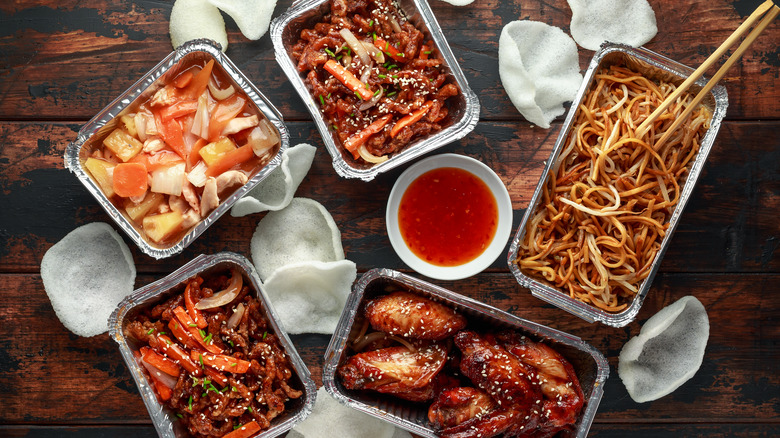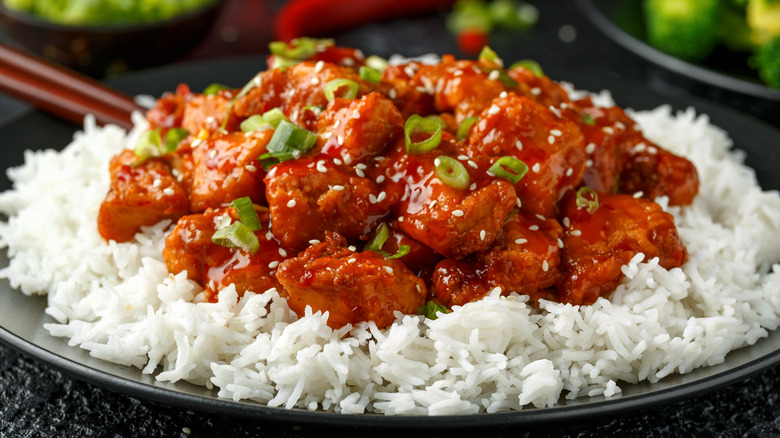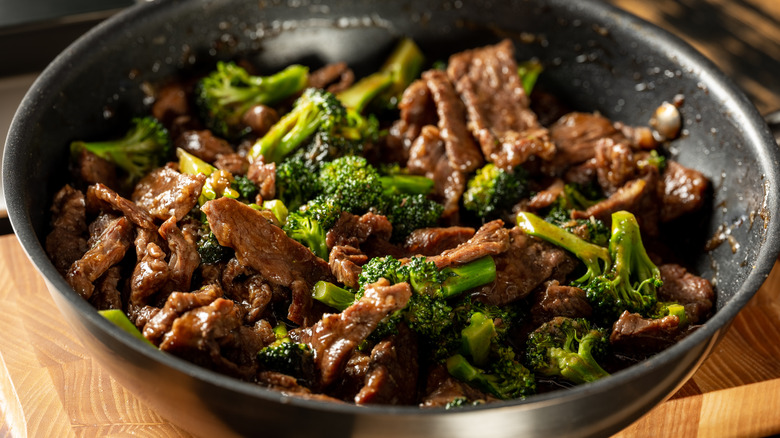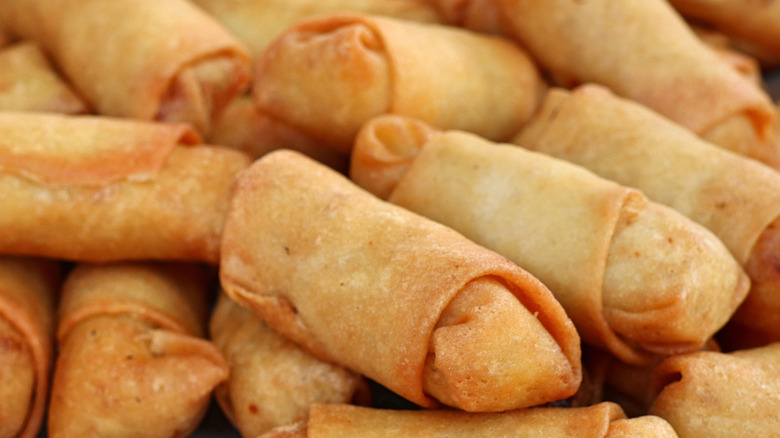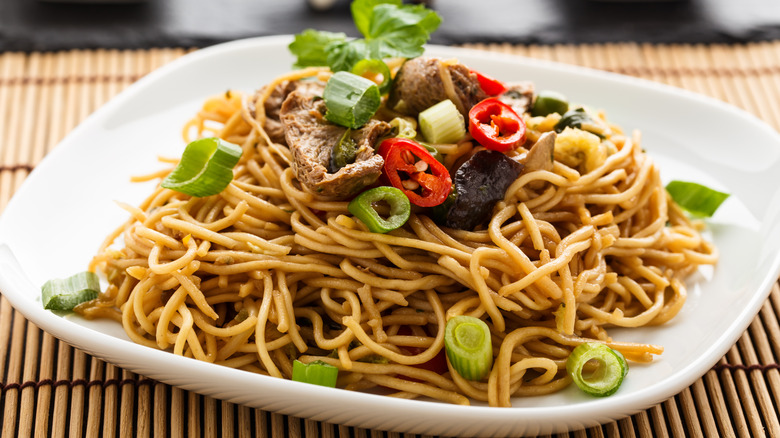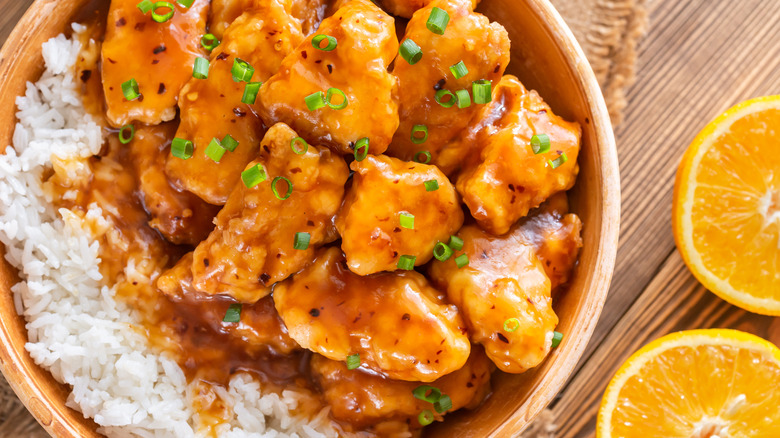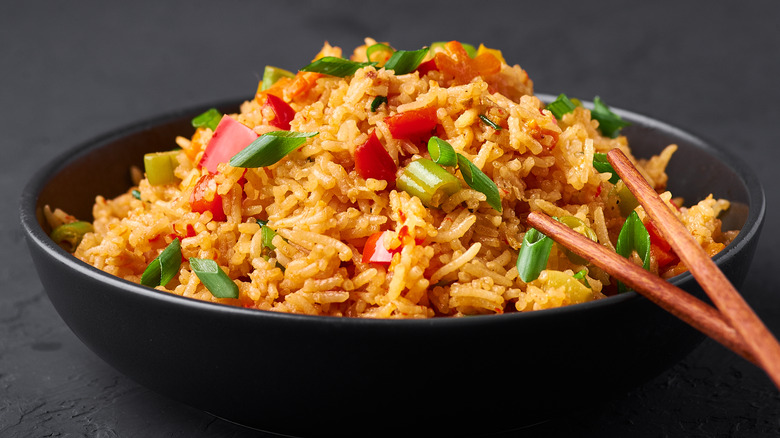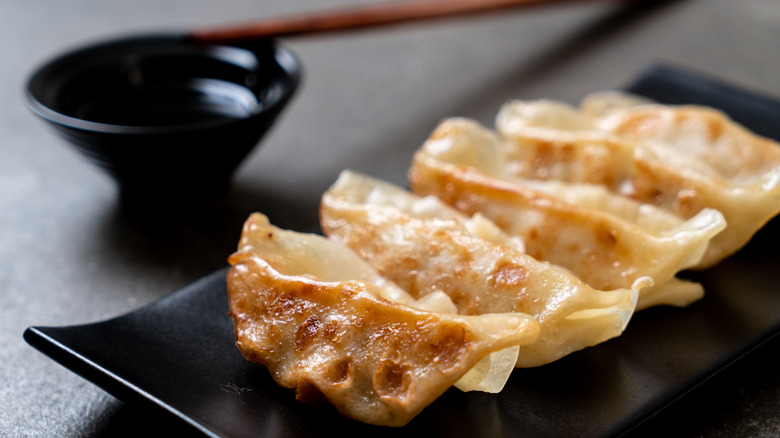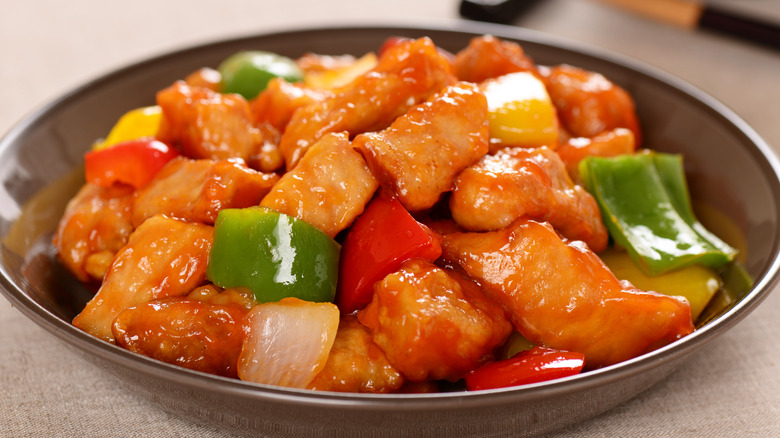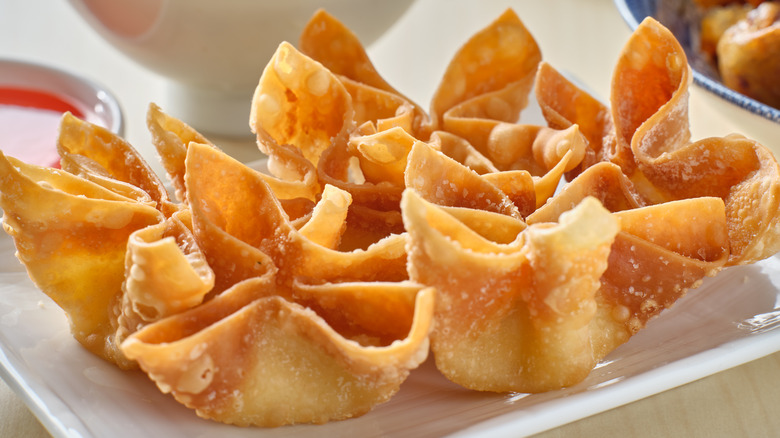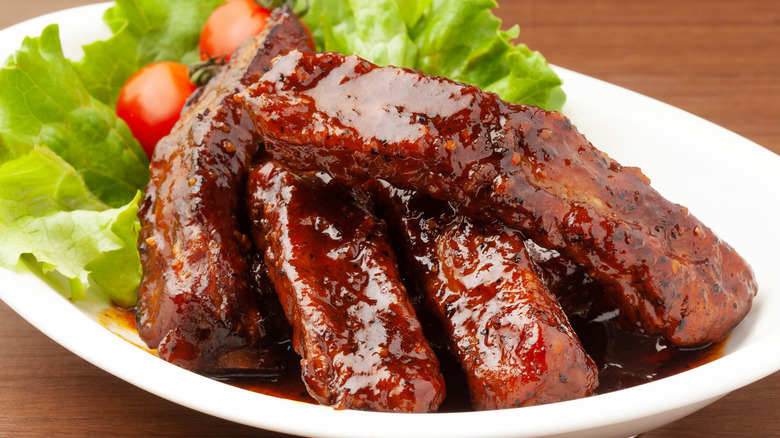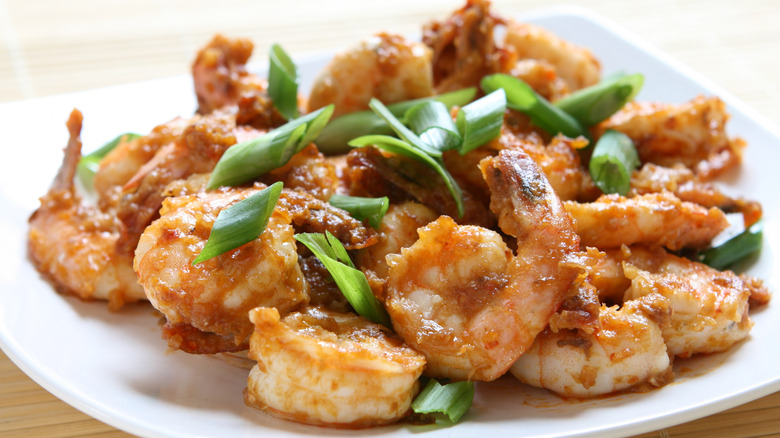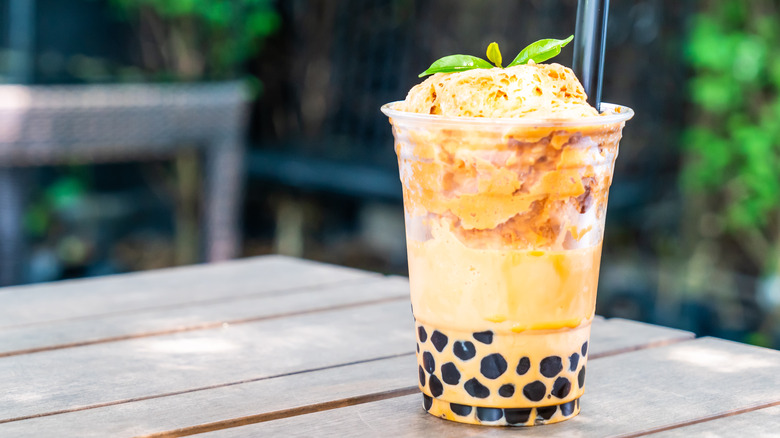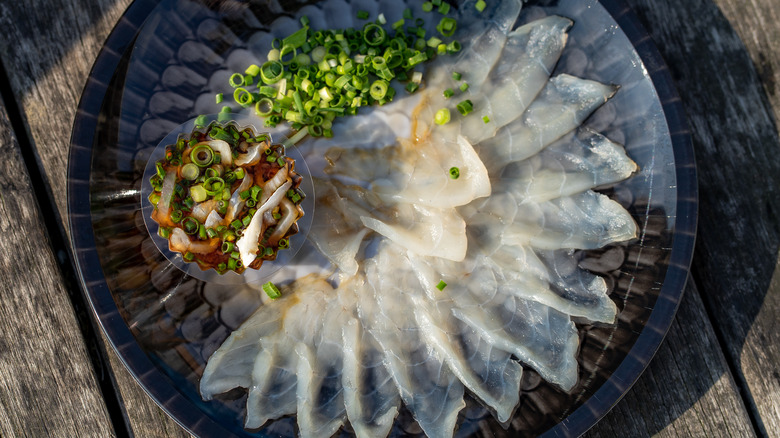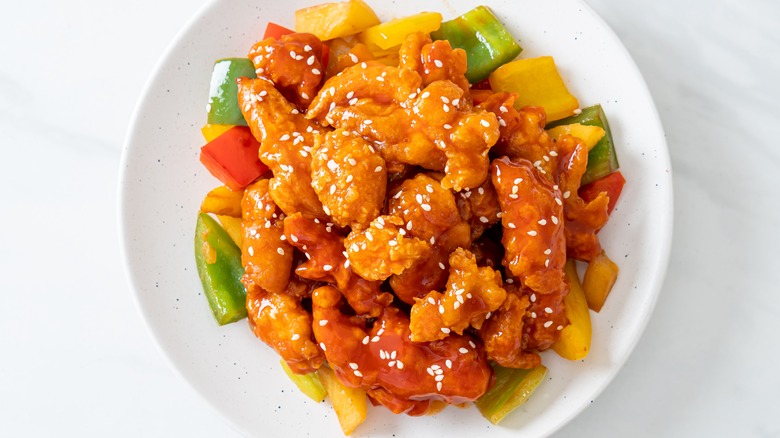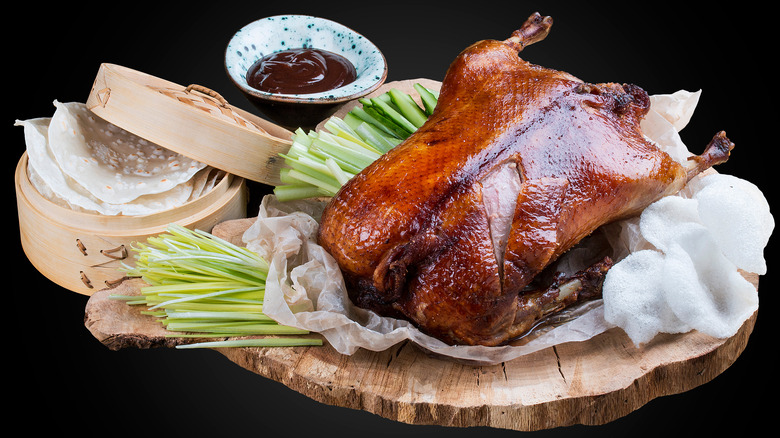15 Unhealthy Chinese Restaurant Foods You Should Always Avoid
Chinese food is one of America's favorite types of cuisine. In 2020, Google data revealed which foods web users searched for most often (for both recipes and restaurant locations), and Chinese food came out on top (via Chef's Pencil). Nation's Restaurant News has reported similar findings, revealing that 36 percent of consumers report eating Chinese food "frequently," while an additional 42 percent say they eat it at least "occasionally."
In fact, Chinese food has been a favorite in America ever since the first large wave of Chinese immigrants arrived here in the mid-1800s, bringing their unique blend of various foods, spices, and cooking techniques to American consciousness (via Oxford Research).
But beware! As much as we love it, not all Chinese food is created equal. There are many healthy protein-packed Chinese food orders which are as nutritious as they are delicious. But there's also plenty of less than healthy Chinese food — high calorie, fatty, sodium-packed disasters that may taste good, but that are terrible for your health— especially if you're ordering them often. Here are some of the ones you'll want to avoid.
General Tso's Chicken
A beloved staple in American-Chinese restaurants, General Tso's chicken is actually not that popular in China today, according to NPR. While the dish is named after general Tso Tsung-t'ang, one of the Chinese military's best-known historical figures, and he reported enjoyed eating it often, people in the Hunan region of China where he once lived don't actually eat the dish much anymore.
Although the original dish wasn't made using sugar, the American-Chinese adaptation is full of the stuff. Although many enjoy the sweet and savory pairing, General Tso's high sugar content is a big part of what makes it so unhealthy. Prevention has called General Tso's saucy blend of cornstarch, orange juice, rice vinegar, and sugar "the recipe for a diabetic coma."
"This dish is breaded, fried, and smothered in a sugary, salty sauce," registered dietitian nutritionist Lauren Harris-Pincus told Eat This, Not That. One order packs almost 2,400 milligrams of sodium per serving, according to Harris-Pincus, and "1,578 calories, a whopping 88 grams fat, and 62 grams of sugar, which is the equivalent of almost three days' worth based on American Heart Association recommendations."
Chinese beef and broccoli
Based on the name, beef and broccoli must be a smart choice when ordering Chinese, right? Wrong! Prevention warned that the salty black bean sauce used in beef and broccoli may contain more than a day's worth of sodium — on it's own! In fact, an order of beef and broccoli at a restaurant like P.F. Chang's can pack 770 calories, 33 grams of fat, 33 grams of sugar, and 2,110 milligrams of sodium. To put that into context, the American Heart Association recommends capping your daily sodium intake at less than 1,500 milligrams — meaning you can't even chown down more than two-thirds of a single serving of beef and broccoli before accidentally soaring over that number.
While you can't order beef and broccoli at a Chinese restaurant without overdoing it on the sodium, there are some easy ways you can cut sodium levels and make this dish at home. Rather than using the standard mix of soy sauce, dark soy sauce, oyster sauce, and sesame oil to flavor your dish, try the American Heart Association's lighter variation made with low-sodium soy sauce, red wine, and honey to slash the recipe's sodium levels dramatically.
Egg rolls and spring rolls
They may look harmless, but egg rolls and spring rolls are anything but healthy. For those who may not be sure of the difference, the wrapper on spring rolls is usually made from flour while the wrapper on egg rolls contains both flour and egg (via Southern Living). Spring rolls are also typically vegetarian, whereas egg rolls contain both vegetables and meat.
However, the problem with both foods isn't really what they're made of or the number of calories they contain when raw — it's what happens to them when they're cooked. That relatively small and lean spring roll or egg roll can soak up fat like a sponge when it's dropped into a deep fryer, increasing its calorie content by 30 percent or more. According to Livestrong, a single fried spring roll can have as many as 150 calories and 4 grams of fat while a larger fried egg roll can pack 200 calories and between 5 to 8 grams of fat.
All that added fat is bad news — especially if you make a habit of ordering egg or spring rolls or pair them alongside an unhealthy entrée. Eating just one serving of fried food daily can increase your risk of death by up to 8 percent (via AARP).
Vegetable lo mein
Vegetable lo mein is an example of a food that sounds fairly harmless but, in reality, is pretty unhealthy. It's "just noodles and vegetables," you could argue, but the portion size is huge so you're getting way more carbs than you need. Plus, the dish is made with massive quantities of oil, making the carbs you're eating that much more unhealthy.
The noodles in lo mein alone, without sauce, can clock in at 200 calories per cup, with a standard serving of the dish having upwards of 900 calories. "This dish offers plenty of sodium, oil, and refined carbohydrates, but very little in the way of fiber and protein," registered dietitian Andy Bellatti explained in an article for Berkeley Wellness.
If you can't live without lo mein, you should consider at least making it healthier. In an article for Livestrong, nutrition expert Jessica Bruno suggested asking your chef to use broth instead of oil when preparing the lo mein. "This is called a 'vegetable stock velveted' preparation and reduces the number of calories in the dish," she explained. If you're cooking lo mein at home, ramp up the amounts of vegetables you use, and dial the noodles way back for a better calorie balance.
Orange chicken
Chinese orange chicken is a wonder of modern cooking — chunks of white or dark chicken meat cut into bite-size pieces, dredged in flour, fried until golden and crispy, and then served in a sweet, zesty sauce made with orange juice, vinegar, garlic, sugar, soy sauce, ginger, red chili flakes, and orange zest.
Interestingly, this is not a traditional Chinese dish, NPR reported. Orange chicken is actually 100 percent American, a creation of a chef working in a Panda Express kitchen in Hawaii back in 1987. He transformed an existing dish, battering and frying the chicken and making the sauce significantly sweeter. Sadly, it's those modifications to the dish that also made it so incredibly unhealthy.
If you were to order orange chicken at the popular eatery P.F. Chang's, you'd be served an entrée boasting 1,160 calories and 55 grams of sugar. When you order dishes like orange chicken or orange beef, you're basically just downing "hunks of fried meat," Jayne Hurley, a senior nutritionist for the Center for Science in the Public Interest told Newsweek. "What you're getting is three quarters of a pound of deep-fried meat, garnished with vegetables," she cautioned.
Fried rice
The fried rice served in many Chinese restaurants is a food that starts out relatively healthy and is soured by massive portion sizes and loads of added fat. "Fried rice is undeniably bad for you, setting you back 450 calories and 14 grams of fat," warned Men's Journal. Nutritionist Jayne Hurley agrees. She told Newsweek that the average serving of fried rice is simply far too large for the average person, providing 4 or 5 cups of super oily rice, minimal vegetables, and "basically three quarters of a day's calories." Registered dietitian Andy Bellatti explained in an article for Berkeley Wellness that "rice, even when not fried, is best eaten as a side dish, as opposed to an entrée."
If all that weren't unhealthy enough, leftover fried rice can harbor bacteria and toxins and is so likely to make people sick that physicians have dubbed the phenomenon "fried rice syndrome" (via LiveScience). Apparently, dry foods like rice often contain Bacillus cereus, or B. cereus. When these foods are heated and left out, this bacteria can trigger production of a toxin which causes severe stomach pain, vomiting, and diarrhea, epidemiologist Sam Crowe cautioned in an interview with USA Today.
Fried pork dumplings
Dumplings have a fascinating history dating back many centuries. As legend has it, the dough balls were created by a Chinese herbal medicine specialist and filled with meats, spices, and vegetables he believed could help people fight off illness during an especially brutal winter. Because the weather at the time was so bad, he fashioned his dumplings into the shape of tiny ears, hoping they would improve circulation and help people to avoid developing frostbite on their ears — an especially common problem at the time (via The World of Chinese).
Fast forward to today and dumplings are still shaped like ears, but they're no longer always a health food — especially if you choose to enjoy yours cooked in oil. Dumplings can be healthy, but much depends on if they were steamed, pan fried, or deep fried, advised HuffPost.
Steamed dumplings are the leanest option in terms of fat content, with pan fried being obviously less healthy and deep fried being the most unhealthy, nutritionist Simone Austin told the site. Even the slightly less greasy pan-fried dumplings can contain 460 calories and 20 grams of fat, which is a lot — especially for an appetizer.
Sweet and sour pork
Many of the Chinese dishes Americans love were actually dreamed up in the U.S. and specifically crafted to appeal to American palettes, and nowhere is this more evident than in the story of the sweet and sour sauce used to coat pork, chicken, and shrimp. According to Chowhound, sweet and sour sauce originated in the early 1900s. Chinese food was gaining popularity in the United States, but spices were scarce and few restaurants had the time to cook their foods in the traditional ways they were used to. To combat this, chefs created an efficient and crowd-pleasing sauce to coat deep-fried chunks of meat — a sauce which included canned pineapple and ketchup. And that's how foods like sweet and sour pork became Chinese restaurant staples.
From the time it was created, sweet and sour pork has been a poor performer nutritionally. The dish "typically serves up 16 teaspoons of sugar, about the same amount in 3 chocolate bars," according to WebMD. Sweet and sour pork is so calorie dense in fact, the site warned, that "even if you split this entree with someone, you're still likely to get more than 800 calories and 48 grams of fat."
Crab rangoon
Crab rangoon is undeniably delicious. But it's also one of the least healthy appetizers you can order at a Chinese restaurant. "Think about it," registered dietitian Kari Hartel wrote in an article for FitDay. "It's cream cheese and a tiny amount of crab meat that is breaded and deep fried and then served with a sugar-laden sweet and sour sauce."
According to CalorieKing, a standard four-piece serving of crab rangoon weighs in at 470 calories and just 11 grams of protein. In comparison, you're getting 50 grams of carbohydrates and 26 grams of fat, 9 of which are saturated.
Also, don't think that because you're eating seafood, the "crab" in your crab rangoon is that nutritious. Instead of actual crab, crab rangoon often contains imitation crabmeat, which is typically made from Alaska pollock that's been minced, rinsed, strained, and dyed, registered dietitian Andrea Klausner told Berkeley Wellness. It's also "blended with sugar, salt, binders like egg whites and starch, flavorings and other ingredients," and it lacks the omega-3s that make other types of fish and seafood so beneficial to your health. "It also has a high sodium content—300 to 600 milligrams or more in three ounces," she continued.
Barbecue spare ribs
Spare ribs — translated from a German word meaning "spear ribs," which referred to the way they were roasted on a spear – come from the bottom section of the ribs and breastbone of a pig, just above where bacon originates (via Spruce Eats).
Coated in five-spice powder and soy sauce, Chinese spare ribs are also usually a brilliant red color. Ideally, this coloring comes from red wine yeast and nanru, which is made from fermented bean curd, according to Bon Appétit. However, "lesser places will go the easy route and rely on food coloring or jarred sauces that are basically thickened mixtures of sugar, salt, and Red No. 2," to get the right coloring on the ribs.
Whichever option you end up with, pork spare ribs are obviously full of fat. "One order can pack in 1.5 times the sodium you should get in a day, along with 64 grams of fat," warned WebMD. "They also can have more sugar than a can of soda." Nutritionist Jayne Hurley agreed, telling Newsweek that the fat and calories you get in a serving of barbecue spare ribs are is equivalent to two full pork chops!
Szechuan shrimp
Szechuan shrimp may sound like an ideal healthy menu option, but be careful: Appearances can be deceiving. "Stir-fried shrimp and vegetables in a spicy sauce seems like a guilt-free pick, but the sauce is often oily, meaning your order racks up around 700 calories," warned Shape. While it's obviously tasty due to all those spices, shallots, peppers, and water chestnuts, the Center for Science in the Public Interest has cautioned that the dish can also pack way too much sodium, with some servings containing between 2,300 and 3,000 mg of the heart-damaging compound (via Consumer Affairs).
And even if you can get past the nutritional challenges, there are other reasons why you may want to keep shrimp off your plate. According to a 2015 Consumer Reports study, 60 percent of frozen shrimp were found to be contaminated with potentially harmful bacteria. Plus, not all shrimp is responsibly sourced, and it can be hard to know when you're ordering from a restaurant.
Milk tea
Named for the bubbly foam found on top of the drink— and not those round, bubble-like pearls of tapioca at the bottom of the cup — bubble tea originated in Taiwan and generally consists of tea mixed with milk, fruit, flavored syrups, and, these days, gummy pearls that make the drink so iconic (via Eat This, Not That).
Because it's generally based around tea and fruit juice, most people wouldn't consider their favorite bubble tea to be on par with the most sugar-packed coffee drinks or milkshakes available, but the drinks are actually very similar nutritionally. According to The Daily Meal, one bubble tea can contain an alarmingly high 50 grams of sugar and nearly 500 calories. "Tapioca pearls — loved for their chewy, candy-like texture — are as bad for your health as actual candy," the site warned.
Researchers at Pepperdine University were so worried about the abundant sugar found in the increasingly popular drink that they conducted one of the first studies ever on bubble tea. Their conclusion: The drink is so overflowing with sugar, we need to develop lower-sugar options ASAP as a measure of protecting public health.
Fugu
Not all foods are considered unhealthy because they are high in sodium or packed with unwanted oils. Some, like fugu (or puffer fish) are considered unhealthy because they can literally kill you. Although thin, fresh slices of this fish are said to be among the most delicious things you could eat, "the intestines, ovaries and liver of fugu contain a poison called tetrodotoxin, which is 1,200 times deadlier than cyanide," cautioned Time. Nevertheless, the market for fugu in Asia is insatiable. Plates of fugu sell for up to $200 a serving and chefs must undergo years of training in order to obtain their fugu preparation license.
Although fugu is considered a delicacy in Japan, the trend has made its way to China and the United States, too. Interestingly, the South China Morning Post explained that "Chinese fisheries have bred the poison out of them, prompting the government to lift a ban on their consumption." Restaurants in the U.S. must obtain a license "to prove [they] are certified to sell non-toxic or toxin-removed fugu," restauranteur Yuta Suzuki told Eater. But if you do any international traveling, you may want to think twice about ordering this dangerous fish.
Sweet and sour chicken
Given that sweet and sour pork would appear to be a less-than-healthy choice (per WebMD), perhaps swapping in chicken for pork might make it a better bet? The answer depends on whether you're talking white versus dark meat chicken, per SFGate. White meat is lower in fat, cholesterol, and calories than dark meat chicken, according to a side-by-side comparison by Foodstruct using data supplied by the USDA (via FoodData Central). On the other hand, white meat chicken has less to offer than dark meat chicken in terms of minerals essential to human health. In any case, however, the sweet and sour chicken on your plate may be made from dark or light meat — or both (just as sweet and sour pork may be made from various pork cuts).
Accordingly, it seems a fair comparison of chicken versus pork (for purposes of ordering sweet and sour) would be one that doesn't take into account the cut in either case. Using Foodstruct's side by side comparison, it turns out you're getting roughly the same amount of protein and fat in both. However, chicken has more cholesterol, and is significantly less rich in several important minerals, including calcium, magnesium, phosphorous, potassium, copper, and zinc. At the same time, pork meat is lower in sodium than chicken. Overall, although chicken has more iron than pork, it appears that, unless iron is your first and only priority, sweet and sour chicken is even more unhealthy than sweet and sour pork.
Peking duck
What could be unhealthy about whole roasted duck, sliced thin and folded into a petite steamed pancake with a few spears of julienned cucumber and green onions, with a dollop of hoisin sauce? That's what you get when you order the dish popularly known in the U.S. as Peking duck, which hails from Beijing, China, according to The Culture Trip. At least at first blush, any roasted meat might sound like a healthier choice than any meat that has been deep-fried, for example. However, that's not true across the board, and least of all, perhaps, in the case of duck.
First, a side-by-side comparison of General Tso's chicken to even plain roasted duck meat reveals that deep-fried chicken is actually lower in saturated fat, according to Foodstruct. Plus, it's actually a lower cholesterol food. As one purveyor of Peking duck notes of its signature dish, "the fattier the duck is, the tastier it becomes." Moreover, despite the fact that Peking duck isn't breaded and slathered in a sugary sauce, it's nevertheless even more likely than General Tso's chicken to cause one's blood sugar to spike. And that's before adding the pancake and the hoisin sauce, both of which are high in carbs, and the latter of which is also particularly high in sugar. If, as noted above, General Tso's is seen by some nutrition experts as a recipe for a diabetic coma, what might they say about Peking duck?!

